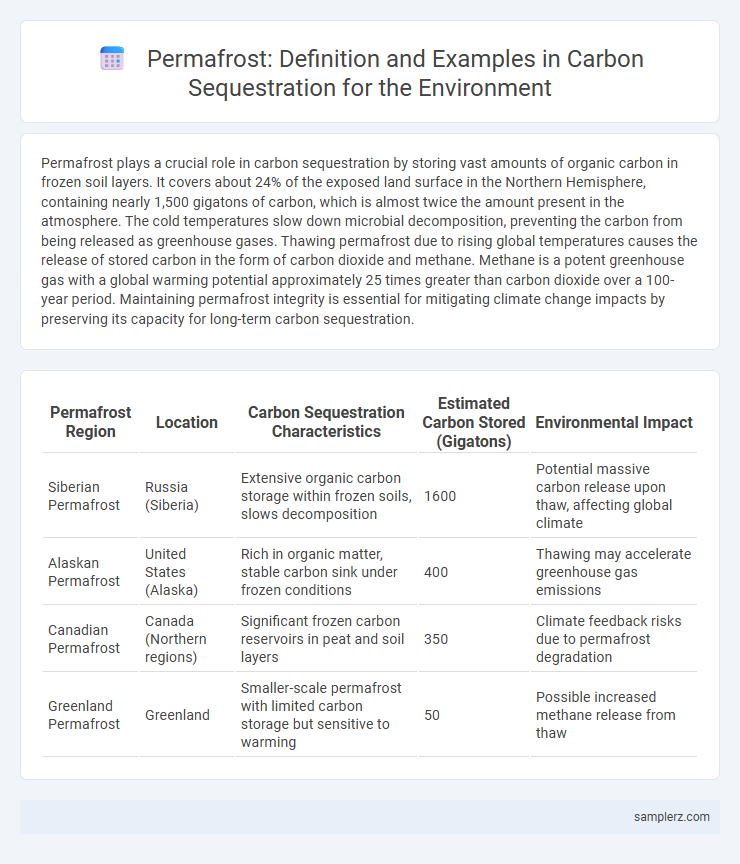Permafrost plays a crucial role in carbon sequestration by storing vast amounts of organic carbon in frozen soil layers. It covers about 24% of the exposed land surface in the Northern Hemisphere, containing nearly 1,500 gigatons of carbon, which is almost twice the amount present in the atmosphere. The cold temperatures slow down microbial decomposition, preventing the carbon from being released as greenhouse gases. Thawing permafrost due to rising global temperatures causes the release of stored carbon in the form of carbon dioxide and methane. Methane is a potent greenhouse gas with a global warming potential approximately 25 times greater than carbon dioxide over a 100-year period. Maintaining permafrost integrity is essential for mitigating climate change impacts by preserving its capacity for long-term carbon sequestration.
Table of Comparison
| Permafrost Region | Location | Carbon Sequestration Characteristics | Estimated Carbon Stored (Gigatons) | Environmental Impact |
|---|---|---|---|---|
| Siberian Permafrost | Russia (Siberia) | Extensive organic carbon storage within frozen soils, slows decomposition | 1600 | Potential massive carbon release upon thaw, affecting global climate |
| Alaskan Permafrost | United States (Alaska) | Rich in organic matter, stable carbon sink under frozen conditions | 400 | Thawing may accelerate greenhouse gas emissions |
| Canadian Permafrost | Canada (Northern regions) | Significant frozen carbon reservoirs in peat and soil layers | 350 | Climate feedback risks due to permafrost degradation |
| Greenland Permafrost | Greenland | Smaller-scale permafrost with limited carbon storage but sensitive to warming | 50 | Possible increased methane release from thaw |
Understanding Permafrost: Nature’s Carbon Vault
Permafrost stores nearly 1,500 billion metric tons of organic carbon, twice the amount currently in the atmosphere, making it a critical carbon vault in the global climate system. When frozen, permafrost prevents the decomposition of organic matter, effectively sequestering carbon over millennia. Thawing permafrost releases greenhouse gases like methane and carbon dioxide, accelerating climate change and disrupting this natural carbon storage mechanism.
The Role of Permafrost in Global Carbon Sequestration
Permafrost regions store approximately 1,500 billion tons of organic carbon, representing nearly twice the amount of carbon currently in the atmosphere. This frozen soil acts as a critical carbon sink by trapping methane and carbon dioxide, preventing their release into the atmosphere. Thawing permafrost due to rising global temperatures threatens to release these greenhouse gases, potentially accelerating climate change.
Arctic Permafrost: A Critical Carbon Reservoir
Arctic permafrost stores approximately 1,500 gigatons of organic carbon, making it a critical carbon reservoir in global climate regulation. The frozen soil traps vast amounts of carbon, preventing its release into the atmosphere and helping mitigate greenhouse gas concentrations. Thawing permafrost due to rising temperatures threatens to release this stored carbon as methane and carbon dioxide, accelerating climate change feedback loops.
Mechanisms of Carbon Storage in Permafrost Soils
Permafrost soils act as significant carbon sinks by trapping organic matter in frozen conditions, which slows down microbial decomposition and the release of greenhouse gases like CO2 and methane. The cryotic environment impedes enzymatic activity, preserving vast amounts of soil carbon accumulated over millennia. This frozen carbon reservoir plays a crucial role in regulating Earth's carbon cycle and mitigating climate change impacts.
Permafrost Peatlands: Long-term Carbon Storage
Permafrost peatlands serve as critical long-term carbon storage reservoirs by trapping organic matter in frozen soil layers, preventing its decomposition and release as greenhouse gases. These ecosystems store an estimated 500 gigatons of carbon, nearly twice the amount currently present in the atmosphere, highlighting their significant role in global climate regulation. Thawing permafrost due to rising temperatures threatens to release this stored carbon, potentially accelerating climate change feedback loops.
Examples of Carbon Sequestration in Siberian Permafrost
Siberian permafrost serves as a critical carbon sink, storing approximately 1300 gigatons of organic carbon, which is nearly twice the amount of carbon currently in the atmosphere. As permafrost thaws, microbial decomposition releases greenhouse gases like methane and carbon dioxide, highlighting the importance of preserving these frozen soils for climate regulation. Research in regions such as the Yamal Peninsula demonstrates how intact permafrost layers prevent carbon emissions, illustrating natural carbon sequestration processes vital for mitigating global warming.
Canadian Arctic Permafrost and Carbon Dynamics
Canadian Arctic permafrost plays a critical role in global carbon sequestration by trapping vast amounts of organic carbon accumulated over millennia. Thawing permafrost releases stored carbon dioxide and methane, significantly impacting carbon dynamics and accelerating climate change. Research indicates that preserving the stability of Canadian Arctic permafrost is essential to maintaining its function as a carbon sink and limiting greenhouse gas emissions.
Vulnerabilities of Permafrost Carbon to Climate Change
Permafrost soils store approximately 1,500 billion metric tons of carbon, making them one of the largest terrestrial carbon reservoirs. Rising global temperatures threaten to thaw these frozen layers, releasing stored carbon dioxide and methane into the atmosphere, which accelerates climate change. Vulnerabilities include increased microbial decomposition and altered hydrology, both of which exacerbate greenhouse gas emissions from previously stable permafrost carbon pools.
Potential Impacts of Thawing Permafrost on Carbon Release
Thawing permafrost in Arctic regions releases significant amounts of stored carbon dioxide and methane, potent greenhouse gases that contribute to global warming. The decomposition of organic matter previously locked in frozen soil accelerates carbon emissions, potentially triggering a positive feedback loop that intensifies climate change. This process threatens to disrupt carbon sequestration balances, amplifying atmospheric greenhouse gas concentrations and impacting global carbon cycles.
Protecting Permafrost: Climate Mitigation Strategies
Permafrost acts as a significant carbon sink, storing nearly 1,500 gigatons of organic carbon, which is twice the amount of carbon currently in the atmosphere. Protecting permafrost through strategies such as maintaining vegetation cover, minimizing soil disturbance, and implementing controlled land use can prevent the release of greenhouse gases. Enhancing natural insulation and promoting sustainable land management are critical for slowing permafrost thaw and supporting climate mitigation efforts.

example of permafrost in carbon sequestration Infographic
 samplerz.com
samplerz.com